

AlphaLISA SureFire Ultra Human and Mouse Phospho-Ezrin (Thr567)/Radixin (Thr564)/Moesin (Thr558) Detection Kit, 100 Assay Points
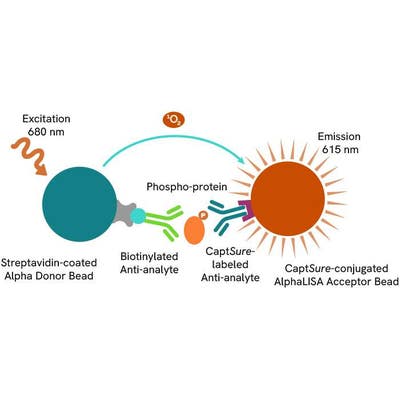

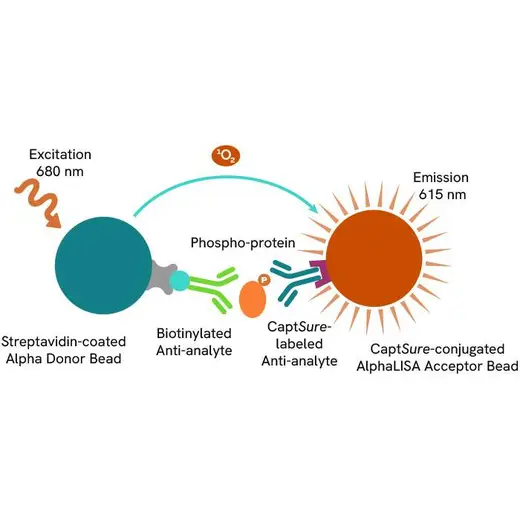


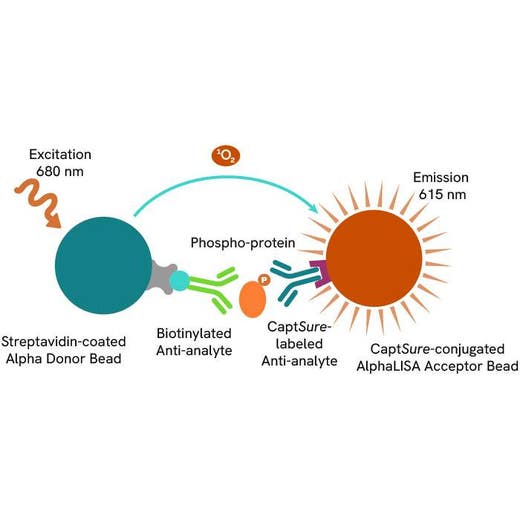


| Feature | Specification |
|---|---|
| Application | Cell Signaling |
| Protocol Time | 2h at RT |









Product information
Overview
Ezrin, Radixin, and Moesin (ERM) proteins link the plasma membrane to the actin cytoskeleton, maintaining cell shape and facilitating adhesion and motility. These proteins are activated through phosphorylation, which stabilizes their open conformation, enabling interaction with the cytoskeleton. Overexpression of ERM proteins is observed in cancers such as breast and pancreatic cancer, enhancing metastatic potential. Dysregulated ERM proteins also contribute to autoimmune disorders like multiple sclerosis.
The AlphaLISA SureFire Ultra Human and Mouse Phospho-Ezrin (Thr567)/Radixin (Thr564)/Moesin (Thr558) Detection Kit is a sandwich immunoassay for the quantitative detection of phospho-Ezrin/Radixin/Moesin in cellular lysates, using Alpha Technology.
Formats:
- The HV (high volume) kit contains reagents to run 100 wells in 96-well format, using a 60 μL reaction volume.
- The 500-point kit contains enough reagents to run 500 wells in 384-well format, using a 20 μL reaction volume.
- The 10,000-point kit contains enough reagents to run 10,000 wells in 384-well format, using a 20 μL reaction volume.
- The 50,000-point kit contains enough reagents to run 50,000 wells in 384-well format, using a 20 μL reaction volume.
AlphaLISA SureFire Ultra kits are compatible with:
- Cell and tissue lysates
- Antibody modulators
- Biotherapeutic antibodies
AlphaLISA SureFire Ultra kits can be used for:
- Cellular kinase assays
- Receptor activation studies
- High-throughput screening for preclinical studies
How it works
Phospho-AlphaLISA SureFire Ultra assay principle
The Phospho-AlphaLISA SureFire Ultra assay measures a protein target when phosphorylated at a specific residue.
The assay uses two antibodies which recognize the phospho epitope and a distal epitope on the targeted protein. AlphaLISA assays require two bead types: Acceptor and Donor beads. Acceptor beads are coated with a proprietary CaptSure™ agent to specifically immobilize the assay specific antibody, labeled with a CaptSure tag. Donor beads are coated with streptavidin to capture one of the detection antibodies, which is biotinylated. In the presence of phosphorylated protein, the two antibodies bring the Donor and Acceptor beads in close proximity whereby the singlet oxygen transfers energy to excite the Acceptor bead, allowing the generation of a luminescent Alpha signal. The amount of light emission is directly proportional to the quantity of phosphoprotein present in the sample.

Phospho-AlphaLISA SureFire Ultra two-plate assay protocol
The two-plate protocol involves culturing and treating the cells in a 96-well plate before lysis, then transferring lysates into a 384-well OptiPlate™ plate before the addition of Phospho-AlphaLISA SureFire Ultra detection reagents. This protocol permits the cells viability and confluence to be monitored. In addition, lysates from a single well can be used to measure multiple targets.
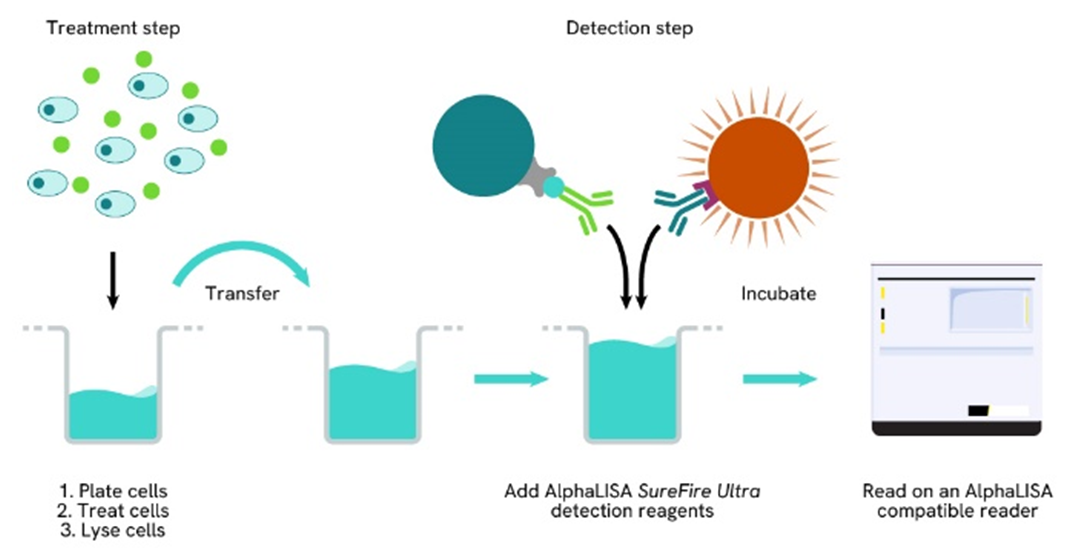
Phospho-AlphaLISA SureFire Ultra one-plate assay protocol
Detection of Phosphorylated target protein with AlphaLISA SureFire Ultra reagents can be performed in a single plate used for culturing, treatment, and lysis. No washing steps are required. This HTS designed protocol allows for miniaturization while maintaining AlphaLISA SureFire Ultra quality.
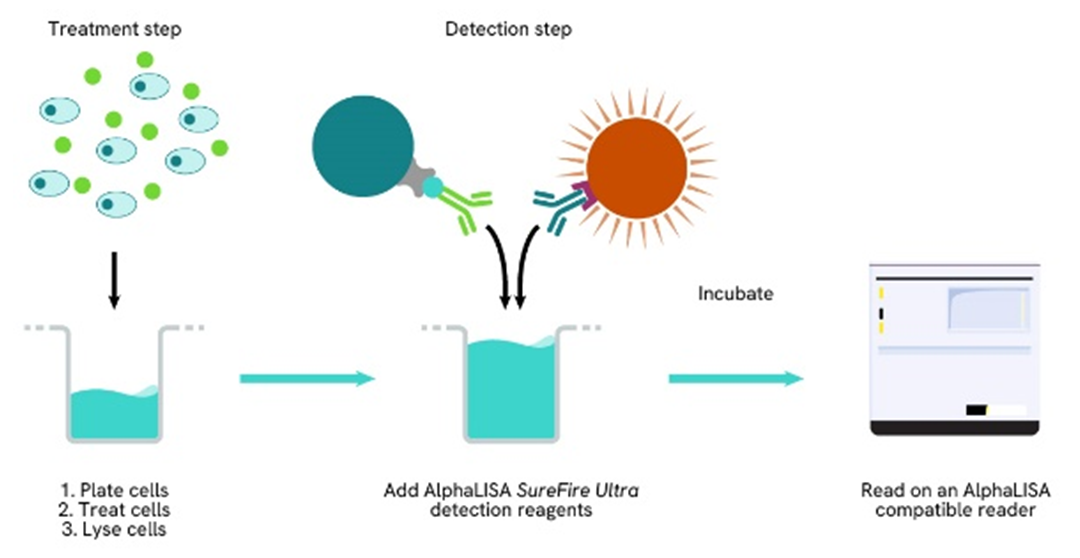
Assay validation
Activation of Phospho Ezrin/Radixin/Moesin in Calyculin A treated cells
HeLa cells were seeded in a 96-well plate (40,000 cells/well) in complete medium and incubated overnight at 37°C, 5% CO2. The cells were treated with increasing concentrations of Calyculin A for 1 hour.
After treatment, the cells were lysed with 100 µL of Lysis Buffer for 10 minutes at RT with shaking (350 rpm). Phospho Ezrin/Radixin/Moesin and Ezrin/Moesin total levels were evaluated using respective AlphaLISA SureFire Ultra assays. For the detection step, lysate was further diluted in Lysis Buffer and 10 µL of cell lysate (approximately 200 cells) was transferred into a 384-well white OptiPlate, followed by 5 µL of Acceptor mix and incubated for 1 hour at RT. Finally, 5 µL of Donor mix was then added to each well and incubated for 1 hour at RT in the dark. The plate was read on an Envision using standard AlphaLISA settings.
As expected, Calyculin A triggered a dose-dependent increase of Ezrin/Radixin/Moesin phosphorylation levels while Total Ezrin/Moesin levels remained unchanged.

Decrease of Phospho Ezrin/Radixin/Moesin levels in Staurosporine treated cells
A549 cells were seeded in a 96-well plate (40,000 cells/well) in complete medium and incubated overnight at 37°C, 5% CO2. The cells were treated with increasing concentrations of Staurosporine for 1 hour.
After treatment, the cells were lysed with 100 µL of Lysis Buffer for 10 minutes at RT with shaking (350 rpm). Phospho Ezrin/Radixin/Moesin and Ezrin/Moesin total levels were evaluated using respective AlphaLISA SureFire Ultra assays. For the detection step, lysates were further diluted and 10 µL of cell lysate (approximately 1,000 cells) was transferred into a 384-well white OptiPlate, followed by 5 µL of Acceptor mix and incubated for 1 hour at RT. Finally, 5 µL of Donor mix was then added to each well and incubated for 1 hour at RT in the dark. The plate was read on an Envision using standard AlphaLISA settings.
As expected, Staurosporine triggered a dose-dependent decrease of Ezrin/Radixin/Moesin phosphorylation levels while no significant changes were detected for Ezrin/Moesin total levels.
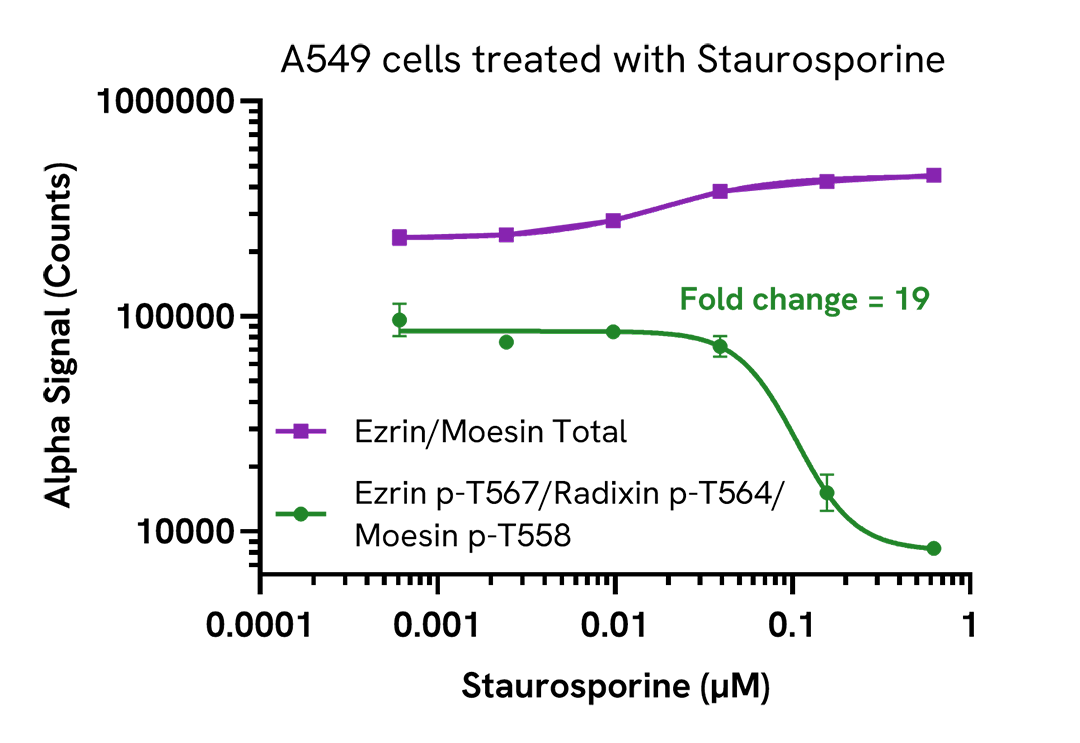
Versatility of Phospho Ezrin/Radixin/Moesin assay in various cell lines
Human and mouse cell lysates were diluted with Lysis Buffer to represent approximately 10,000 cells/datapoint. Ezrin/Radixin/Moesin Phospho levels were evaluated using the AlphaLISA SureFire Ultra assay kit.
For the detection step, 10 µL of cell lysate was transferred into a 384-well white OptiPlate, followed by 5 µL of Acceptor Mix and incubated for 1 hour at RT. Finally, 5 µL of Donor Mix was then added to each well and incubated for 1 hour at RT in the dark. The plate was read on an Envision using standard AlphaLISA settings.
The Phospho Ezrin/Radixin/Moesin assay contains phospho and total antibodies which recognise the phosphorylated forms of these three proteins. As expected, this assay was able to detect endogenous levels of these phospho proteins in a wide range of cell lines.

Specifications
| Application |
Cell Signaling
|
|---|---|
| Automation Compatible |
Yes
|
| Brand |
AlphaLISA SureFire Ultra
|
| Detection Modality |
Alpha
|
| Product Group |
Kit
|
| Protocol Time |
2h at RT
|
| Shipping Conditions |
Shipped in Blue Ice
|
| Target |
ERM
|
| Target Class |
Phosphoproteins
|
| Target Species |
Human
Mouse
|
| Technology |
Alpha
|
| Therapeutic Area |
Autoimmunity
Oncology
|
| Unit Size |
100 assay points
|
Video gallery
Resources
Are you looking for resources, click on the resource type to explore further.
The definitive guide for setting up a successful AlphaLISA SureFire Ultra assay
Several biological processes are regulated by...
Discover Alpha SureFire® Ultra™ assays, the no-wash cellular kinase assays leveraging Revvity's exclusive bead-based technology...
This document includes detailed tables listing HTRF™, AlphaLISA™ SureFire® Ultra™, and Alpha SureFire® Ultra™ Multiplex assays...


Loading...
How can we help you?
We are here to answer your questions.






























